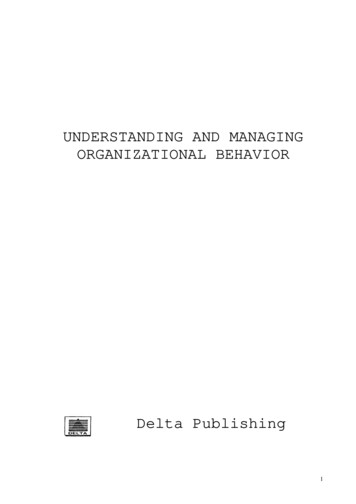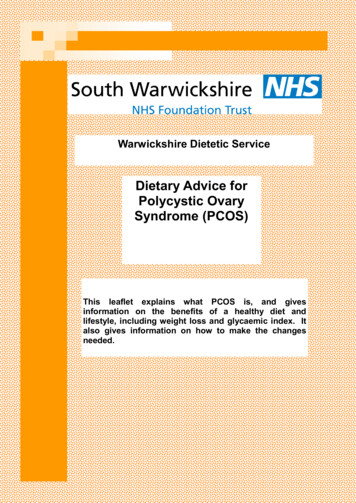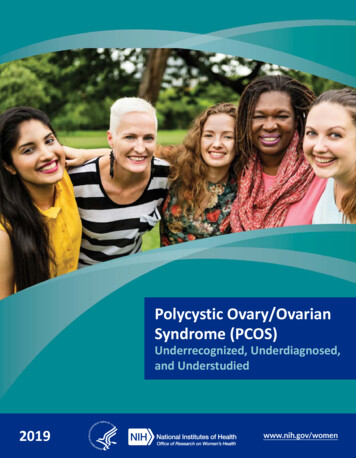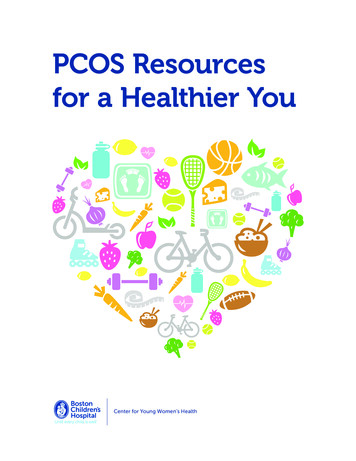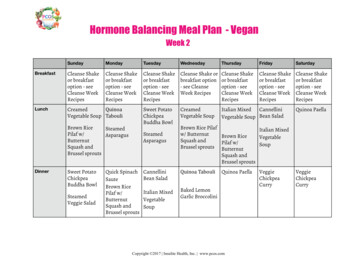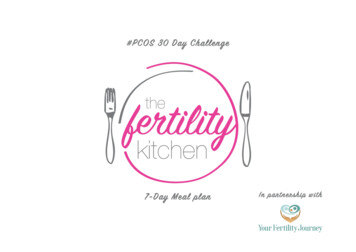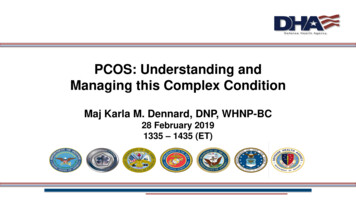
Transcription
PCOS: Understanding andManaging this Complex ConditionMaj Karla M. Dennard, DNP, WHNP-BC28 February 20191335 – 1435 (ET)
PresenterMaj Karla M. Dennard, DNP, WHNP-BCDNP Program Phase 2 Site DirectorJoint-Base San AntonioLackland AFB, Texas2
Maj Karla M. Dennard, DNP, WHNP-BCMajor Karla M. Dennard is the Uniformed ServicesUniversity of the Health Sciences, Graduate School ofNursing, Clinical Assistant Professor assigned to the 59thTraining Squadron at Joint-Base San Antonio, Lackland AFB,Texas. As the Doctor of Nursing Practice Program Phase 2Site Director, Major Dennard is directly responsible for theplanning, implementation and evaluation of the Family andWomen’s Health Nurse Practitioner clinical residency. Inthis role, she develops educational and administrative toolsfor the adherence and sustainment of accreditation by theCommission on Collegiate Nursing Education and theNational Organization of Nurse Practitioner Faculties.Additionally, Major Dennard maintains her own medicalcompetencies and clinical currency by providing keysupport to the Family Health and Women’s Health Clinics.“Medically Ready Force Ready Medical Force”3
Disclosure Maj Karla Dennard has no relevant financial or non-financial relationships to disclose relatingto the content of this activity; or presenter(s) must disclose the type of affiliation/financialinterest (e.g. employee, speaker, consultant, principal investigator, grant recipient) withcompany name(s) included. The views expressed in this presentation are those of the author and do not necessarilyreflect the official policy or position of the Uniformed Services University of the HealthSciences, the Department of Defense, or the U.S. Government. This continuing education activity is managed and accredited by the Defense Health AgencyJ7 Continuing Education Program Office (DHA J7 CEPO). DHA J7 CEPO and all accreditingorganizations do not support or endorse any product or service mentioned in this activity. DHA J7 CEPO staff, as well as activity planners and reviewers have no relevant financial ornon-financial interest to disclose. Commercial support was not received for this activity.“Medically Ready Force Ready Medical Force”4
Learning ObjectivesAt the conclusion of this activity, participants will be able to: Define Polycystic Ovarian Syndrome (PCOS) Describe the recommended Diagnosing Criteria Identify the clinical and biochemical features/markers of PCOS Evaluate a patient that presents with PCOS features Develop a plan of care for a woman newly diagnosed with PCOS Describe pharmaceutical treatment of symptoms of PCOS Explain the importance of early recognition/prevention of PCOS Describe the treatment goals for women with PCOS“Medically Ready Force Ready Medical Force”5
Polycystic Ovarian Syndrome Syndrome of Ovarian Dysfunction Hyperandrogenism, ovulatorydysfunction, polycystic ovaries Stein & Leventhal in 1935 Known as Stein-LeventhalSyndrome until 1960s Heritable disorder Most common androgen excessdisorder in reproductive-aged women Adversely affects endocrine, metabolicand cardiovascular health(jeanhailes.org.au/health-a-z/pcos)(Setji & Brown, 2014; Marshall & Dunaif, 2012; Sirmans & Pate, 2014)“Medically Ready Force Ready Medical Force”6
Etiology and Pathophysiology Uncertain etiology – appears to be genetic High levels of insulin in blood/ obesity Ovaries produce excess testosterone Reduced levels of sex-hormone binding globulin Resulting in increased free testosterone Increased adipose tissue causes increased androgens (hirsutism/virilization) Increased estrogens (inhibits FSH negative feedback loop) Multiple ovarian cysts – immature follicles Appear as a “String of Pearls” on xplained)(Setji & Brown, 2014; Kabel, 2016)“Medically Ready Force Ready Medical Force”7
Epidemiology Changes in diagnostic criteria affect prevalence (6% to 18%) 10-15% of US women have PCOS 80% of women presenting with androgen excess have PCOS 70% of women will have oligomenorrhea/amenorrhea or prolonged erratic menses Hirsutism occurs on 70% of women with PCOS(Dreamstime.com)“Medically Ready Force Ready Medical Force”(Sirmans & Pate, 2014; Wolf et al., 2018)8
Epidemiology 40% present with Acne (usually cystic) Insulin Resistance present in 60-70% of women w/PCOS (independentof obesity) 40% experience infertility issues Metabolic Syndrome more common in women with PCOS 35% of women with PCOS suffer from Depression(Dreamstime.com)(Sirmans & Pate, 2014; Wolf et al., 2018)“Medically Ready Force Ready Medical Force”9
Predisposing Factors Family History of PCOS Premature Adrenarche (prior to 8yrs) GDM or Impaired Glucose in Pregnancy Onset of DM before Menarche Anti-Epileptic Drugs (Valproate)(depkewellness.com)(Kabel, 2016)“Medically Ready Force Ready Medical Force”10
Associated Comorbidities Obesity Insulin Resistance/ Diabetes Dyslipidemia Metabolic Syndrome Endometrial Cancer Infertility Depression/ Anxiety(Peigne & Dewailly, 2014)(Peigne & Dewailly, 2014 Setji & Brown, 2014)“Medically Ready Force Ready Medical Force”11
Clinical Manifestations Oligo/Amenorrhea Hirsutism Acne Male-pattern Hair Loss Central Obesity Clitoromegaly Deepening of xcess-body-hair-pcos)(Setji & Brown, 2014; Sirmans & Pate, 2014; Kabel, 2016)“Medically Ready Force Ready Medical Force”12
Diagnosing Criteria(Sirmans & Pate, 2014; Teede et al., 2018)“Medically Ready Force Ready Medical Force”13
Differential Diagnoses Nonclassical Congenital Adrenal Hyperandrogenism (NCCAH) Cushing’s Syndrome Ovarian Hyperthecosis Prolactin Secreting Tumors Ovarian Insufficiency Thyroid Disease Pregnancy(Slideshare.net/lifecareCentre)(Sirmans & Pate, 2014)“Medically Ready Force Ready Medical Force”14
EvaluationPatient History Menstrual pattern Obesity Onset, progression/problems Hirsutism Lifestyle Patterns (especially of Obese) Diet/ Exercise Fertility Family History Infertility Menstrual Disorders Hursutism in relativesPhysical Examination BMI – Body HabitusBlood PressurePresence of AcneMale Pattern BaldnessAcanthosis NigricansClitoromegalyDeepening of VoiceHirsutism(Mayoclinic.org)(Kabel, 2016)“Medically Ready Force Ready Medical Force”15
EvaluationUltrasonography Small immature ovarian follicles 12 small follicles (between 2mm-9mm) “String of Pearls” Increased ovarian size (1.5 to 3 times)Laboratory Tests HCGSerum Total TestosteroneDHEASAndrostedione or Serum 17HydroxyprogesteroneProlactinTSHCBC (if menorrhagia)FSH/LH 1:3 ratio(girlgoneprimal.blogspot.com)(Kabel, 2016)“Medically Ready Force Ready Medical Force”16
Hirsutism Excess Terminal Body Hair (thick/ pigmented) May be noted Upper lip Chin Peri-areolar area Midsternal Lower Abdomen Upper de et al., 2010)“Medically Ready Force Ready Medical Force”17
Hirsutism Ethnic Variations/Ferriman-Gallwey ScoringSystem US/UK Black/White Women / 8 Mediterranean/Hispanic/Middle Eastern Women / 9 South American Women / 6 Asian Women / iry-women-scale/)(Fede et al., 2010)“Medically Ready Force Ready Medical Force”18
Management LIFESTYLE INTERVENTION Diet/exercise (5-10% weight loss) LOCAL THERAPIES/COSMETICS Waxing, Electrolysis (Vaniqa) PHARMACEUTICAL INTERVENTIONS NON-FERTILITY CONTRACEPTIVES Any COC, Drospirenone has low androgenicity but risk for VTE METFORMIN (BMI 25) 500-1500mg/d ANTI-ANDROGENIC AGENT Spironolactone (100-200mg/d—check potassium level before initiation/annually);Finasteride/Propecia (2.5-5mg/d) INFERTILITY METFORMIN/CLOMID/LETROZOLE GONADOTROPINS DEPRESSION/ANXIETY MANAGEMENT (prevalence 38% AND 25%, respectively) NOT ON ANTIDEPRESSANTS TREAT PCOS FIRST ON ANTIDEPRESSANTS TAPER OFF OR CONTINUE WHILE STARTING PCOS TREATMENT(Setji & Brown, 2014; Sirmans & Pate, 2014; Kabel, 2016; Chaudhari et al., 2017; Teede, 2018)“Medically Ready Force Ready Medical Force”19
Treatment Goals Ameliorate hyperandrogenic features (hirsutism, acne, scalp hair loss) Reduction of health factors Management of underlying metabolic abnormalities Prevention of endometrial hyperplasia/carcinoma Contraception f/those desiring pregnancy prevention Ovulation induction f/those desiring pregnancy Improved Quality of Life Impact of condition Depression and/or Anxiety“Medically Ready Force Ready Medical Force”20
Continued Management Cardiovascular Blood Pressure BMI Fasting Blood Lipid 2-Hr Oral Glucose Tolerance Test(2H-OGTT) or Fasting Blood Glucosew/A1C (2-H OGTT preferred as Fastinglacks sensitivity in PCOS) Nonalcoholic Fatty Liver Fertility Depression/ Anxiety“Medically Ready Force Ready Medical Force”(fda.gov)(Teede et al., 2018)21
Ethnic Disparities No difference between African-American& Caucasian women Higher prevalence in Asian women whencompared with AA/Caucasian but tendto be less hirsute Hispanics have highest prevalence ofinsulin-resistance/metabolic syndromecompared to non-Hispanic Studies suggest prevalence of PCOSin Hispanic women is double Phenotype is much worse in spanic-women-pcos)(Ketefian et al., 2010; Sam et al., 2015; Engmann et al., 2017)“Medically Ready Force Ready Medical Force”22
Key Take Aways Most common androgen excess disorder in reproductive aged womenDiagnosis of ExclusionUnknown etiologyGenetic predispositionRotterdam Criteria is recommendedMay lead to serious complications Prevention/early detection are important Treatment Goals Continued Management/lifestyle interventions post-diagnosis“Medically Ready Force Ready Medical Force”(healthcare.utah.edu)23
Polycystic Ovarian Syndrome“Medically Ready Force Ready Medical Force”24
ReferencesChaudhari, A.P., Mazumdar, K. and Mehta, P.D. (2017). Anxiety, depression, and Quality of Life in Women with Polycystic Ovarian Syndrome. IndianJournal of Psychological Medicine, 40(3), 239-246.Medicine Network. (2017). Racial and Ethnic Differences in Polycystic Ovarian Syndrome (PCOS) Metabolic Phenotype. American Journal ofObstetrics and Gynecology, 216(5), 493.Fede, G.D., Mansueto, P., Pepe, I., Rini, G.B., and Carmina, E. (2010). High Prevalence of Polycystic Ovary Syndrome in Women with Mild Hirsutismand No Other Significant Clinical Symptoms. American Society of Reproductive Medicine. Fertility and Sterility, 94(1).Kabel, A.M. (2016). Polycystic Ovarian Syndrome: Insights and Pathogenesis, Diagnosis, Prognosis, Pharmacological and Non-PharmacologicalTreatment. Journal of Pharmacological reports, 1(1).Ketefian, A., Torralba, C.A., Pall, M., Ezeh, U, and Azziz, R. (2010). The Phenotype of Polycystic Ovarian Syndrome (PCOS) in Hispanic vs. NonHispanic White Women. American Society of Reproductive Medicine. Fertility and Sterility, 94(4), S193-S194.Marshall, J.C. and Dunaif, A. (2012). Should All Women with PCOS be Treated for Insulin Resistance? American Society of reproductive Medicine.Fertility and Sterility, 97(1).“Medically Ready Force Ready Medical Force”25
ReferencesPeigne, M. and Dewailly, D. (2014). Longterm Complications of Polycystic Ovary Syndrome (PCOS). Annales d’Endocrinologie, 75(4), 194-199.doi:10.1016/j.ando.2014.07.111Sam, S., Scoccia, B., Yalamanchi, S. and Mazzone, T. (2015). Metabolic Dysfunction in Obese Hispanic Women with Polycystic Ovarian Syndrome.Human Reproduction, 30(6), 1358-1364.Setji, T.L. & Brown, A.J. (2014). Polycystic Ovary Syndrome: Update on Diagnosis and Treatment. The American Journal of Medicine, 127: 912-919.Sirmans, S.M., Pate, K.A. (2014). Epidemiology, Diagnosis, Management of Polycystic Ovarian Syndrome. Clinical Epidemiology, 6, 1-13.Teede, H.J., Misso, M.L., Costello, M.F., Dokras, A., Laven, J., Moran, L., Piltonen, T. and Norman, R.J. (2018). Recommendations from theInternational Evidence-Based Guideline for the Assessment and Management of Polycystic Ovary Syndrome. American Society forReproductive Medicine. Fertility and Sterility, 110(3).Wolf, W.M., Wattick, R.A., Kinkade, O.N., and Olfert, M.D. (2018). Geographical Prevalence of Polycystic Ovary Syndrome as Determined by Regionand Race/Ethnicity. International Journal of Environmental Research and Public Health, 15, 2589; doi:10.3390/ijerph15112589“Medically Ready Force Ready Medical Force”26
How to Obtain CE CreditsWe will provide the language, please leave as placeholder“Medically Ready Force Ready Medical Force”27
Define Polycystic Ovarian Syndrome (PCOS) Describe the recommended Diagnosing Criteria Identify the clinical and biochemical features/markers of PCOS Evaluate a patient that presents with PCOS features Develop a plan of care for a woman newly diagnosed with PCOS Describe phar
